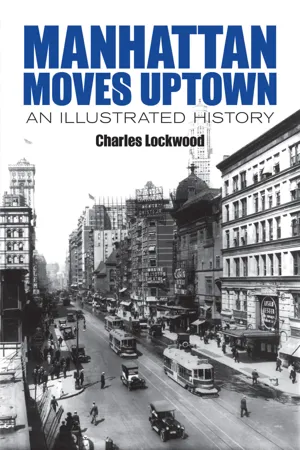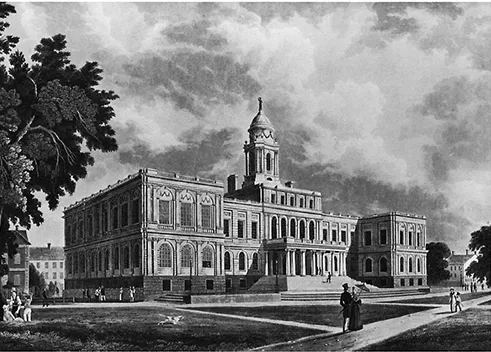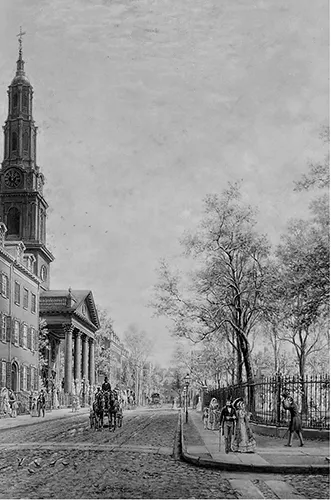![]()
1
When City Hall was completed in 1811 at Broadway and Chambers Street, New Yorkers found their sentiments expressed in Blunt’s Stranger’s Guide: the building was “the handsomest structure in the United States; perhaps, of its size, in the world.” Its light French Renaissance detail was a novelty to New Yorkers, who were accustomed to the Georgian architectural tradition, and the white marble walls facing south, east, and west were a startling sight in a city built of red brick and wood. No one complained that the city fathers had saved some money by facing the north wall in common brownstone. The building stood at the outskirts of the city, and the north side, everyone figured, “would be out of sight to all the world” for years to come.
The city fathers were very wrong. Less than ten years later the 1820 census named New York the most populous city in the nation, and small town modesty vanished forever. Now New Yorkers boasted about their city and predicted a splendid future. “It almost amounts to a certainty,” declared James Hardie in his 1827 Description of New York, “that unless we shall be afflicted with war, pestilence, famine, earthquake, or some other dreadful visitation of Divine Providence, we shall, at the close of the present century, not only equal but far surpass either of the great cities of London or Paris in population, trade, commerce, navigation, arts, science.”
In 1823 John Pintard, a merchant and civic enthusiast, brashly predicted that the city’s population — 123,706 by the 1820 census — would reach 260,000 by 1840, 520,000 by 1860, and 800,000 by 1875. Such growth appeared impossible to New Yorkers who remembered the badly damaged, demoralized city of 12,000 that the British Army, after a seven-year occupation, left at the end of the Revolutionary War. But Pintard warned the skeptics that his prediction was “no fond, delusive anticipation,” and he was right. His figures, in fact, erred on the low side. New York’s population actually reached 312,710 in 1840, 813,660 in 1860, and crossed the one million mark by 1875, an eightfold increase in fifty years.
This fast-rising population led to a building boom and the rapid growth of the city northward up Manhattan Island. By 1820 the city had already engulfed City Hall, whose plain brownstone north wall was now a daily sight to the thousands of New Yorkers coming to work down Broadway from their homes uptown. The northward rush of the city up Manhattan Island thrilled them; they believed that their city would be impressive and lovely as well as simply populous. “What enormous and magnificent edifices will ... be erected!” boasted one newspaper in 1836. “What charming private residences! What majestic city halls, courts, colleges, libraries, academies … What fine rows of buildings! What streets and squares! What parks, theaters, opera houses, arcades, and promenades! … Will not this become one of the most wealthy, populous, and splendid cities of the globe?”
In the early nineteenth century the 200-foot spire of Trinity Church was the favorite spot for New Yorkers and visitors wishing to admire the sweep of the city. Trinity, located at Broadway and Wall Street, was not the brownstone church now at that location but its predecessor, a modest “plain Gothick” structure built in 1788–1790. Nor was its spire the tallest in the city. The tower of St. Paul’s Chapel, a few blocks north, at Broadway and Fulton Street, and the one on St. John’s Chapel on Varick Street at the outskirts of the city, were each nearly a hundred feet higher. But Trinity’s location was one of the best known and busiest in the city, surrounded by the finest residences, hotels, shops, and business buildings.
The site, furthermore, was one of the best loved in the New York of the 1820s. The parish of Trinity Church first conducted services there in a small wooden building in 1697. That building was long gone, as was the lovely stone church completed in 1737 and burned in 1776 during the British occupation. The churchyard, however, had remained intact all these years, and in 1827 the New York Mirror called it “one of the most ancient in this city, having been the resting place of successive generations for upwards of 130 years.”
Trinity Church’s tower was not officially open to the public, but the sexton or a vestryman was usually willing to show visitors the way to the spire for a modest gratuity. A winding stairway, with benches along the way for the weary, led to the top. There, more stairs and several ladders led people to a small room at the top of the tower with windows on four sides.
The view more than justified the trouble of the long climb. There lay New York, a “mammoth beehive” of right-angled brick walls and pitched slate roofs, stretching out in all directions, 200 feet below. The noise of the city was just a busy hum at this height, but the people in the spire could see the brightly colored omnibuses making their way up and down Broadway, tiny pedestrians hurrying along the sidewalks, and horses pulling heavily loaded wagons through the un-paved streets. Visitors and even New Yorkers were surprised at the size and vitality of the city. “I was not prepared to find such a large and populous city on a coast where two hundred years ago there was only an insignificant village,” declared Baron Axel Leonhard Klinckowstrom, a Swedish naval officer and writer, in 1818.
To the south one could see several blocks of rooftops and chimneys, ending abruptly at the trees of the Battery. These blocks were largely residential, the mansions of the rich and the boardinghouses of the poor intermixed on the narrow, irregular streets, which had been “made as the wants of the inhabitants required, or the owners of large tracts of land laid them out, selling their lots fronting on the new streets,” wrote the Herald years later. Broadway, which started at the Battery, was eighty feet wide, lined with poplars, and, viewed from the church tower, it “cut through the inhabitations of men … like a deep channel” on its northward route.
View of lower Manhattan, ca. 1842–1845
The Battery was an oasis of grass and quiet in the already bustling New York. Philip Hone, a businessman who became Mayor of New York in 1825, wrote “A more delightful scene can nowhere be found.” And even the acerbic and critical Mrs. Frances Trollope admitted that “no city could boast ... a public promenade … more beautiful.” Here New Yorkers passed afternoons and evenings, strolling along curving, tree-shaded paths and enjoying the sea breezes and the sight of New York Bay. The Bay’s waters “must be the most beautiful in the world,” thought the English actress Fanny Kemble, who also delighted in the sight of hundreds of sailing ships “glancing like graceful sea-birds, through their native element.”
To the east of Trinity Church, the city sloped gently down toward the East River. The streets east of Broadway had been largely residential at the end of the Revolution; in the 1820s, however, the countinghouses and warehouses, which served the rising demands of shipping and trade, were displacing the last residences. One hundred years earlier, Pearl Street had run along the shore of the East River, but landfill operations had extended Manhattan into the river, first as far as Water Street, then Front Street, and finally South Street. So many ships from the transatlantic trade docked along the East River that by the 1820s the east shore of Manhattan was “a forest of masts.” Beyond that lay the unspoiled farmland of Brooklyn, the rolling hills, open meadows, and stands of trees so different from the closely built rooftops of the city below the church tower.
To the west of Trinity Church were several blocks of pleasant residences, which ended at the Hudson River, sometimes called the North River. The farms and forests of New Jersey extended beyond the opposite shore. Shipping had also taken over the Manhattan shoreline here, although there were fewer sailing vessels than along the East River. Domestic shipping had settled along the Hudson, and its skiffs and flatboats, though not as glamorous as the transatlantic vessels, carried on a thriving trade with the South and now trafficked with upstate New York and the Midwest by the Erie Canal, which opened in 1826.
But it was the view to the north that excited the greatest wonder of visitors to Trinity Church’s tower. By the 1820s, New York had already begun its fabled march uptown, slowing only for war or depression, obliterating the hills, farms, and streams that once dotted Manhattan. Carpenters and masons were erecting thousands of modest but handsome red brick row houses every year, but the city’s population was growing so fast that houses were in short supply and families often moved into half-finished buildings. Other New Yorkers were even less fortunate in their search for a place to live and, when their leases expired, moved into the jail, on Chatham Street, until they found other homes.
By the same decade, the city was solidly built as far as Canal Street, and scattered development had pushed so far north that, in 1825, the Commercial Advertiser declared: “Greenwich is now no longer a country village. Such has been the growth of our city that the building of one block more will completely connect the two places; and in three years’ time, at the rate buildings have been erected the last season, Greenwich will be known only as a part of the city, and the suburbs will be beyond it.”
The panorama from Trinity Church thrilled New Yorkers because they were proud of the city’s growth and new buildings. A fine mansion or an extravagant shop, in their eyes, was more than a sign of the owner’s private wealth; it was a reflection of the public’s well-being and New York’s rising greatness. Standing in the tower, they proudly pointed out the greenery of St. John’s Park, a mile to the north. Its successful development in the 1820s proved that New York had the daring and vision, as well as the people and wealth, to become a great city.
Back in 1803 Trinity Church had tried to introduce the delights of the residential squares of London’s West End to a piece of land it owned along the Hudson River beyond the city. It laid out St. John’s Park, which was bounded by Varick, Beach, Hudson, and Laight streets, and then offered the lots around its perimeter for ninety-nine-year leases, subject to restrictions that would permit only first-class row houses to be constructed. The church even built St. John’s Chapel on Varick Street, facing the square. The site, however, was too far beyond the city at that time, and rich New Yorkers, who were expected to move in, were put off by the leasehold nature of the lots and St. John’s Park’s frankly British inspiration. The development of the park did not get underway, and the lovely chapel stood virtually alone among cow pastures and marshland, for twenty years.
In the mid-1820s New Yorkers transformed Trinity’s failed urban vision into “the most desirable residence” and “the fairest interior portion of this city.” The church decided to sell rather than lease its property in the area, and in 1827 it deeded the square itself to the owners of the sixty-four surrounding lots. Within a year these landholders had fenced in the square for the princely sum of $25,000, thereby reserving the park for their sole enjoyment. Catalpas and cottonwoods, horse chestnut and silver birch trees were planted throughout, and gravel paths wound among them and the ornamental shrubs and flower beds.
Encouraged by successes like the development of St. John’s Park, New Yorkers were bold enough to question who was so blind as not to see that New York would always be the great city of the western world. But the sight from the tower of Trinity Church in the 1820s and 1830s was deceptive. “New York viewed from a distance,” declared one English visitor in 1824, “has the air of a metropolis ... A walk through it, however, dissipates much of the idea of grandeur excited by the distant view.”
New York had much to do before it truly became one of the leading cities of the world. Despite its soaring population and geographical expansion, the city had changed little, during the past hundred years, in such basic services as water supply, sanitation, fire fighting, and public health. The streets were “the dirtiest in the Union,” the Evening Post admitted in 1821, and were littered with ashes, bits of food, even dead animals. City garbage collection and street cleaning were sporadic at best. “Multitudes of rats infested almost every building,” according to Englishman James Boardman, and scavenging pigs were “quite at home” in the streets everywhere in the city. Slaughterhouses, distilleries, glue works, and stables were a nuisance in all but the finest neighborhoods. Sewers were unknown, and raw sewage was often thrown into the streets along with household garbage.
St. John’s Chapel and St. John’s Park, ca. 1840
Because of these nearly medieval conditions, yellow fever and cholera epidemics regularly ravaged the city. New Yorkers usually fled the infected neighborhood at the first sign of disease, and the city spread quicklime and coal dust in the streets and kept fires burning night and day in hopes of cleansing the air of contagion. The bonfires, however, were nearly as great a threat to the city as the epidemics they were intended to combat. Fires were one of the sights of New York, according to most European visitors; the city was so densely built and the water supply so limited that the volunteer fire companies were fortunate if they lost just one building and kept the fire from spreading to its neighbors.
Still, New Yorkers displayed a passionate pride in their city that amused visitors, particularly those from Great Britain, who had a more objective view of its strengths and weaknesses. Alexander Mackay, a British journalist, recalled that “Americans are justly very proud” of New York and “its residents passionately attached to it.” One winter day, after landing in New York, Mackay shared a sleigh going to the Astor House with “a young New Yorker, who had been in Europe for more than a year … ‘There goes the old city!’ said he in his enthusiasm, as we entered Broadway. ‘I could almost jump out and hug a lamp-post.’”
Anyone who was away from New York for more than a year or two was amazed, on his return, by the changes in the city. “The time that you have been abroad has made great changes, in everything that meets the eye,” wrote James Fenimore Cooper to his friend W. B. Schubrick in 1833. “To us they have been gradual and almost unperceived, but will strike you with great force; even in your own New York, you will scarcely recognize some of the places with which you were most familiar.”
The growth and change delighted most people. “New York never saw such days as the present since it was a city,” boasted the Evening Post in 1825. “The streets are so obstructed by the great number of buildings going up and pulling down, that they have become almost impassable, and a scene of bustle, noise, and confusion prevails that no pen can describe, nor any but an eye witness imagine.” New Yorkers were gratified by the demolition of old buildings that reminded them of their city’s less prosperous, less powe...



